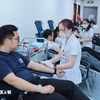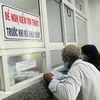HCM City, (VNA) - Hospitals in Ho Chi Minh City have been striving to reach five goals to improve the quality of examinations and treatment, including safety, patient satisfaction, efficient management, effective services, and appropriate costs and prices.
Eight years ago, the city Paediatric Hospital 1, for instance, set up a Red Alert emergency aid procedure to save young patients.
The procedure has won first prize in a contest on activities that have improved quality of examination and treatment, organised by the city’s Department of Health.
Dr Nguyen Thanh Hung, head of the Paediatric Hospital, said the procedure had helped reduce the number of complicated administrative procedures, which in turn had improved the rapid response of emergency aid.
“It has been very effective in saving patients with many injuries,” Hung said.
In 2013, for example, two children were brought to the hospital for emergency aid after being stabbed by their neighbour nine times with a knife.
The hospital’s Red Alert procedure was activated and within only 15 minutes, doctors and nurses were available to provide emergency aid, conducting a five-hour operation in which two children were saved.
“In the last several years, the department has expanded the procedure, which now links hospitals in the city,” he said.
Last year, the Ministry of Health instructed all hospitals in the country to carry out the procedure to treat patients in need of emergency aid.
In addition, the Thu Duc District Hospital has successfully piloted an electronic medical records project, creating a database on patients’ health to enhance the tracking of their condition and treatment.
Nguyen Minh Quan, director of Thu Duc District Hospital, said the hospital’s doctors were ready to share their expertise with other hospitals in the country.
“Databases between hospitals are connected, which helps reduce the need for repeated tests and makes it easier to carry out treatment at family medicine clinics,” Quan said.
Among other efforts, Cho Ray Hospital and Gia Dinh People’s Hospital have used software for the control of antibiotics, while Binh Dan Hospital has used robots to assist 20 surgeries.
The hospitals’ activities were honoured at an awards ceremony held in HCM City for a contest to select outstanding activities related to examination and treatment quality.
Many of the hospitals have carried out activities to increase patient safety. For instance, Nguyen Trai Hospital’s traditional medicine ward uses a plastic card attached to the patient’s bed that notes the number of needles used in acupuncture treatment.
This alerts other medical personnel involved in the procedure about how many needles that need to be removed.
Dr Tang Chi Thuong, the deputy head of the Department of Health, said at a meeting reviewing activities and the contest, that the department had issued a handbook on what health facilities should do to improve quality of treatment.
The handbook is based on 80 criteria on hospital quality, Thuong said.
The department has also increased training for more than 1,600 people and staff working in wards and divisions who are in charge of quality management at hospitals.
A database of 3,399 treatment guidelines for hospitals from the city to grassroots levels has been completed in order to standardise treatment.
Thuong said that successful programme models should be replicated at other hospitals.
Luong Ngoc Khue, head of the Department of Health Examination and Treatment at the Ministry of Health, said: “Patients in the city as well as the southern region have received benefits from these improved activities.”
Dr Nguyen Thi Thoa, deputy head of the city’s Health Department’s medical affairs division, said that it had assessed hospitals’ activities for improvement last year.
The assessment focused on five groups of criteria: patient satisfaction, human resources, professional activities, development of medical specialities, and quality of treatment.
The results showed that city-level hospitals such as 115 People’s Hospital, Gia Định People’s Hospital, Tu Du Obstetrics Hospital and Trung Vuong Hospital had high and comprehensive improvement.
Thoa said those hospitals had average scores of 3.43 out of a maximum of five.
District-level hospitals had an average score of 2.93 and private hospitals an average score of 2.77.
The department has instructed city-level hospitals to continue training and technical assistance for district-level hospitals, especially District 3 and 9 hospitals, which had a score of less than 2.5, she said.
Private hospitals, especially those in the plastic surgery and cosmetics field, are in need of improvement as well. Eighteen out of 46 of them in the city scored under 2.5.-VNA
Eight years ago, the city Paediatric Hospital 1, for instance, set up a Red Alert emergency aid procedure to save young patients.
The procedure has won first prize in a contest on activities that have improved quality of examination and treatment, organised by the city’s Department of Health.
Dr Nguyen Thanh Hung, head of the Paediatric Hospital, said the procedure had helped reduce the number of complicated administrative procedures, which in turn had improved the rapid response of emergency aid.
“It has been very effective in saving patients with many injuries,” Hung said.
In 2013, for example, two children were brought to the hospital for emergency aid after being stabbed by their neighbour nine times with a knife.
The hospital’s Red Alert procedure was activated and within only 15 minutes, doctors and nurses were available to provide emergency aid, conducting a five-hour operation in which two children were saved.
“In the last several years, the department has expanded the procedure, which now links hospitals in the city,” he said.
Last year, the Ministry of Health instructed all hospitals in the country to carry out the procedure to treat patients in need of emergency aid.
In addition, the Thu Duc District Hospital has successfully piloted an electronic medical records project, creating a database on patients’ health to enhance the tracking of their condition and treatment.
Nguyen Minh Quan, director of Thu Duc District Hospital, said the hospital’s doctors were ready to share their expertise with other hospitals in the country.
“Databases between hospitals are connected, which helps reduce the need for repeated tests and makes it easier to carry out treatment at family medicine clinics,” Quan said.
Among other efforts, Cho Ray Hospital and Gia Dinh People’s Hospital have used software for the control of antibiotics, while Binh Dan Hospital has used robots to assist 20 surgeries.
The hospitals’ activities were honoured at an awards ceremony held in HCM City for a contest to select outstanding activities related to examination and treatment quality.
Many of the hospitals have carried out activities to increase patient safety. For instance, Nguyen Trai Hospital’s traditional medicine ward uses a plastic card attached to the patient’s bed that notes the number of needles used in acupuncture treatment.
This alerts other medical personnel involved in the procedure about how many needles that need to be removed.
Dr Tang Chi Thuong, the deputy head of the Department of Health, said at a meeting reviewing activities and the contest, that the department had issued a handbook on what health facilities should do to improve quality of treatment.
The handbook is based on 80 criteria on hospital quality, Thuong said.
The department has also increased training for more than 1,600 people and staff working in wards and divisions who are in charge of quality management at hospitals.
A database of 3,399 treatment guidelines for hospitals from the city to grassroots levels has been completed in order to standardise treatment.
Thuong said that successful programme models should be replicated at other hospitals.
Luong Ngoc Khue, head of the Department of Health Examination and Treatment at the Ministry of Health, said: “Patients in the city as well as the southern region have received benefits from these improved activities.”
Dr Nguyen Thi Thoa, deputy head of the city’s Health Department’s medical affairs division, said that it had assessed hospitals’ activities for improvement last year.
The assessment focused on five groups of criteria: patient satisfaction, human resources, professional activities, development of medical specialities, and quality of treatment.
The results showed that city-level hospitals such as 115 People’s Hospital, Gia Định People’s Hospital, Tu Du Obstetrics Hospital and Trung Vuong Hospital had high and comprehensive improvement.
Thoa said those hospitals had average scores of 3.43 out of a maximum of five.
District-level hospitals had an average score of 2.93 and private hospitals an average score of 2.77.
The department has instructed city-level hospitals to continue training and technical assistance for district-level hospitals, especially District 3 and 9 hospitals, which had a score of less than 2.5, she said.
Private hospitals, especially those in the plastic surgery and cosmetics field, are in need of improvement as well. Eighteen out of 46 of them in the city scored under 2.5.-VNA
VNA
























